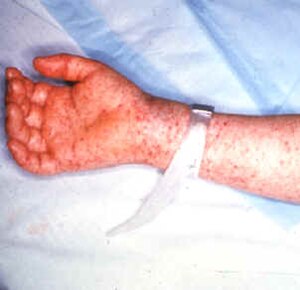Rocky Mountain spotted fever
| Rocky Mountain spotted fever | |
|---|---|
 |
|
| Petechial rash caused by Rocky Mountain spotted fever on the arm | |
| Classification and external resources | |
| Specialty | Infectious disease |
| ICD-10 | A77.0 |
| ICD-9-CM | 082.0 |
| DiseasesDB | 31130 |
| MedlinePlus | 000654 |
| eMedicine | emerg/510 med/2043 ped/2709 oph/503 derm/772 |
| MeSH | D012373 |
Rocky Mountain spotted fever (RMSF), also known as blue disease, is the most lethal and most frequently reported rickettsial illness in the United States. It has been diagnosed throughout the Americas. Some synonyms for Rocky Mountain spotted fever in other countries include “tick typhus,” “Tobia fever” (Colombia), “São Paulo fever” or “febre maculosa” (Brazil), and “fiebre manchada” (Mexico). It is distinct from the viral tick-borne infection, Colorado tick fever. The disease is caused by Rickettsia rickettsii, a species of bacterium that is spread to humans by Dermacentor ticks. Initial signs and symptoms of the disease include sudden onset of fever, headache, and muscle pain, followed by development of rash. The disease can be difficult to diagnose in the early stages, and without prompt and appropriate treatment it can be fatal.
The name “Rocky Mountain spotted fever” is something of a misnomer. The disease was first identified in the Rocky Mountain region, but beginning in the 1930s, medical researchers realized that it occurred in many other areas of the United States. It is now recognized that the disease is broadly distributed throughout the contiguous United States and occurs as far north as Canada and as far south as Central America and parts of South America. Between 1981 and 1996, the disease was reported from every state of the United States except for Hawaii, Vermont, Maine, and Alaska.
...
Wikipedia
